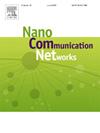Novel design of phase-frequency detector using a new flip-flop with reset capability in QCA technology
IF 4.7
4区 计算机科学
Q2 ENGINEERING, ELECTRICAL & ELECTRONIC
引用次数: 0
Abstract
QCA (Quantum-dot Cellular Automata) technology is considered as an innovative method in the design of electronic circuits due to its ability to perform fast processing calculations. In this article, for the first time, some new designs of digital circuits were designed and simulated in the best case with a new and practical technique. This article uses a unique technique to design a d-flip-flop with reset capability with 33 cells, an area of and a delay of 0.75 clock cycles, a PFD (Phase-Frequency Detector) of the first type with 88 cells, an area of and a delay of one clock cycle, and a second type of PFD with 119 cells, an area of and has designed a delay of 1.75 clock cycles. Also, the number of cells and the occupied area of the proposed designs have improved by 33.74 % and 59 %, respectively, compared to different authorities. Therefore, the proposed designs are considered among the best designs among different authorities.
利用 QCA 技术中具有复位功能的新型触发器设计新颖的相频检测器
量子点元胞自动机(Quantum-dot Cellular Automata, QCA)技术由于能够进行快速的处理计算,被认为是电子电路设计中的一种创新方法。本文首次采用一种新的实用技术,在最佳情况下设计和模拟了一些新的数字电路设计。本文采用独特的技术设计了具有复位能力的33个单元、面积为0.02μm2、延迟为0.75时钟周期的d型触发器、88个单元、面积为0.07μm2、延迟为1时钟周期的第一种PFD (Phase-Frequency Detector)和119个单元、面积为0.09μm2、延迟为1.75时钟周期的第二种PFD。此外,与其他权威机构相比,拟议设计的单元数和占用面积分别提高了33.74%和59%。因此,所提出的设计在不同权威机构中被认为是最佳设计。
本文章由计算机程序翻译,如有差异,请以英文原文为准。
求助全文
约1分钟内获得全文
求助全文
来源期刊

Nano Communication Networks
Mathematics-Applied Mathematics
CiteScore
6.00
自引率
6.90%
发文量
14
期刊介绍:
The Nano Communication Networks Journal is an international, archival and multi-disciplinary journal providing a publication vehicle for complete coverage of all topics of interest to those involved in all aspects of nanoscale communication and networking. Theoretical research contributions presenting new techniques, concepts or analyses; applied contributions reporting on experiences and experiments; and tutorial and survey manuscripts are published.
Nano Communication Networks is a part of the COMNET (Computer Networks) family of journals within Elsevier. The family of journals covers all aspects of networking except nanonetworking, which is the scope of this journal.
 求助内容:
求助内容: 应助结果提醒方式:
应助结果提醒方式:


